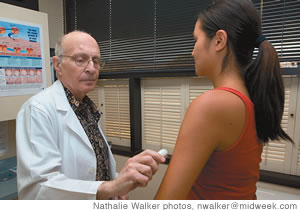The Ins And Outs Of Skin Care
Interviewed by Melissa Moniz
Wednesday - October 08, 2008
E-mail this story | Print this page | Comments (0) | Archive
 Del.icio.us Share
Del.icio.us Share

Interviewed by Melissa Moniz
Dr. Philip Hellreich
Dermatologist
Where did you receive your schooling and training?
I obtained my undergraduate degree at Hamilton College in Clinton, New York. I obtained my medical degree at the State University of New York Upstate Medical Center in Syracuse, New York. My internship and dermatology residency were done at the United States Public Health Service Hospital in Staten Island, New York. I then completed a fellowship in dermatology at Columbia University Presbyterian Hospital in New York City.
How long have you been practicing?
I arrived in Hawaii in 1971 and practiced at the Honolulu Medical Group for one year before starting my private practice in Kailua. I am also an associate clinical Professor of Medicine at the John A. Burns School of Medicine.
What is your area of specialty?
All diseases of the skin, including skin cancer, melanoma, acne, eczema, skin infections and psoriasis.
What is the most common reason patients come in for treatment?
The top three are probably acne, skin cancer and eczema.
Are those sectioned off mainly by age, or does each of the three affect all ages?
Eczema most frequently begins in childhood and often starts in infancy. Most patients eventually outgrow it. Various studies show that 10 to 30 percent of infants are affected with eczema, but only 2 to 10 percent of adults have eczema, so obviously they’re outgrowing it. The eczema is often associated with other allergic disorders, such as asthma and hay fever.
Skin cancer is more common in Caucasians. The less well you tan, and the more easily you sunburn, the greater your risk of developing skin cancer and melanoma. When I first started my practice I almost never saw skin cancer in Asians, but now I’m seeing it much more often because they’re spending more time in the sun. I treat patients of all ages, from infancy to very old age.
In regard to acne has there been any new breakthroughs in medications or treatmentw to help eliminate and prevent it?
The treatment of acne usually consists of using topical medications, most commonly benzoyl peroxide, topical antibiotics, and one of the retinoids, such as Retin-A or Differin. Retinoids prevent the plugging of the hair follicle, which is the initial lesion in acne. When topical therapy alone does not work, oral antibiotics, most often a tetracycline derivative, areused. Accutane is used for severe cystic acne when nothing else works, but Accutane can cause birth defects and other serious adverse effects, and should be used only in severe cystic acne not responsive to other treatments. Therefore, many dermatologists are reluctant to prescribe Accutane, and are using other modalities such as phototherapy with blue light or Intense Pulsed Light.

|
Are there ever cases of acne where there is nothing that helps or can help?
The answer is no. I’ve never had a patient where nothing has worked. Amajority of patients will respond to topical medication alone, and most of the rest will respond when you add an oral antibiotic. The antibiotics are used to suppress a bacteria that normally resides in the skin, and because they have anti-inflammatory effects. So now we’re using very low dose antibiotics that have only anti-inflammatory effects and do not kill bacteria, because if we use too many antibiotics, then we may cause bacterial resistance. Hawaii has the dubious distinction of having the highest rate of MRSA, or resistant staphylococcal infections, in the nation. These resistant infections used to occur only in hospitals, but we’re now seeing more community acquired resistant staphylococcal infections manifesting as boils and cellulites of the skin, which if not adequately treated may cause serious complications, including death.
You mentioned boils. What is that and how do you get it?
A boil is an infection of a hair follicle. If you have a number of follicles infected, it’s called a carbuncle. The best treatment of this kind of infection is surgical incision and drainage. You numb it with a local anesthetic and then use a scalpel to open up the wound and remove the pus, which is causing the pain and discomfort. Then you can do a culture and sensitivity test to determine what kind of bacteria is causing the infection, and which antibiotics it is sensitive to.
Do you have any tips or pointers to quickly get rid of a pesky pimple that shows up?
You don’t attack it. If you attack your zits and squeeze and poke them, you will probably cause scarring. What I can do is inject a small amount of cortisone into the lesion, and it makes it go away very quickly. It doesn’t mean that you come in the day before the prom or your wedding and expect a miracle. But these injections will resolve most inflamed acne lesions within five to seven days.
What tips do you have on skin cancer prevention?
First of all, stay out of the sun. There’s no absolutely perfect sun-screen. So assuming that you’re not a nude sunbather, you need to be the color of your okole. If you’re darker than that then you’re increasing your risk of skin cancer and aging of the skin. If you’re a surfer, you should purchase a rash-guard 50 to use while surfing. And also be aware that the more fair you are, the more you’ll burn and the greater your risk of skin cancer. In fact, if you have more than three blistering sunburns, you significantly increase your risk of getting melanoma.
E-mail this story | Print this page | Comments (0) | Archive
Most Recent Comment(s):













